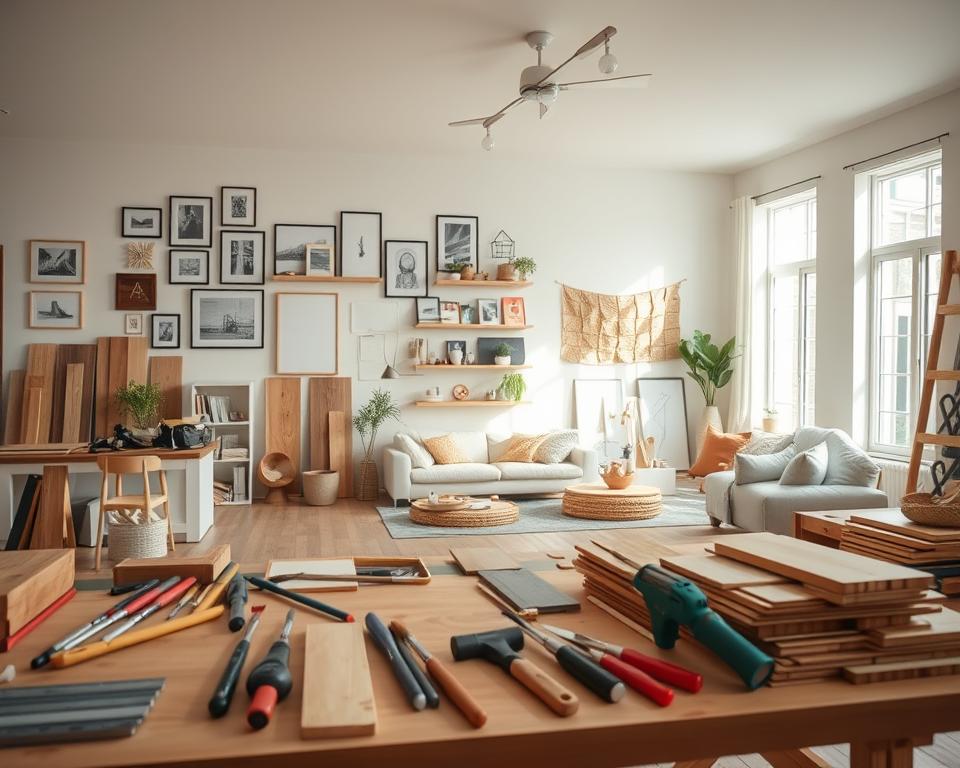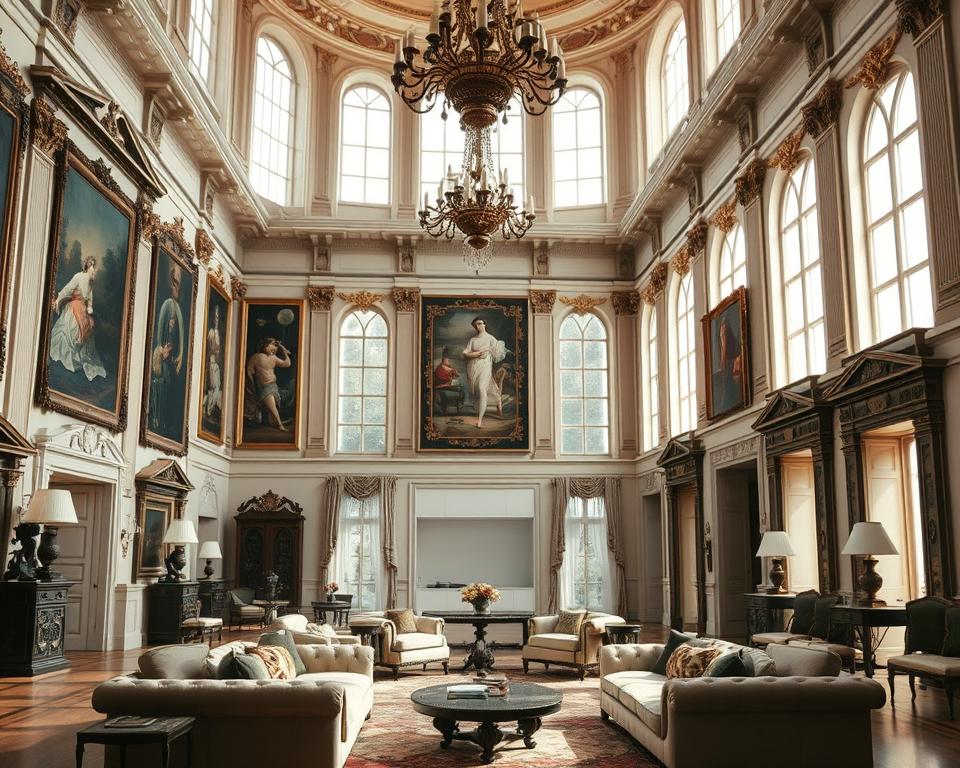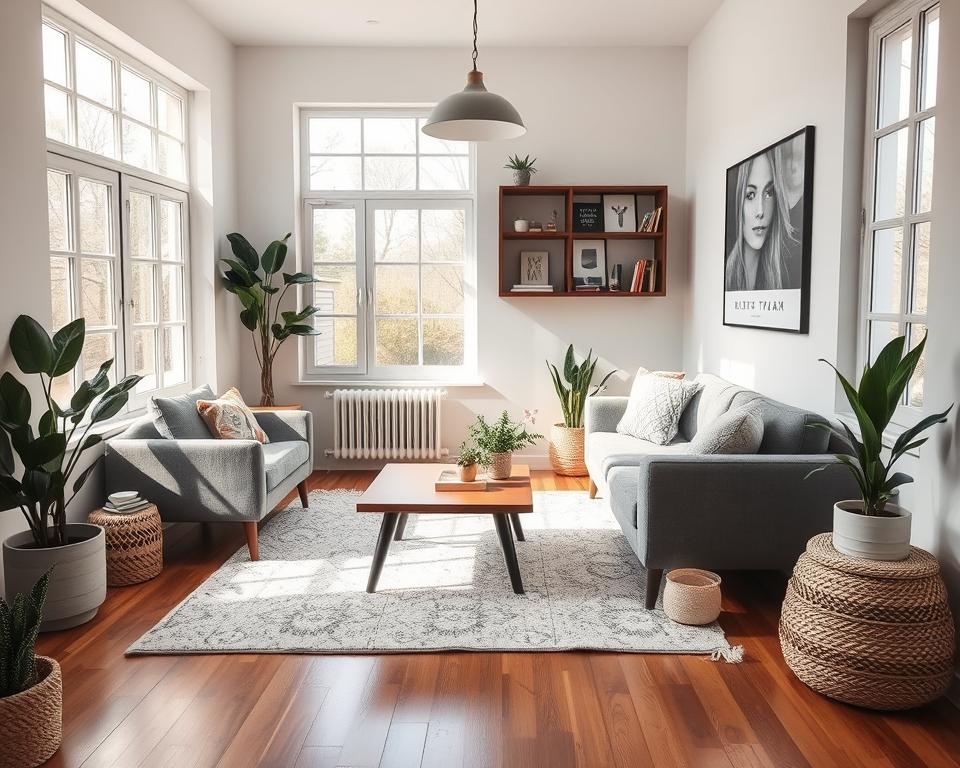Did you know that Interior Designers earn an average of $67,400 annually? By 2032, their job growth is expected to be 4%.
This shows the potential and demand for interior design careers. If you’re considering a career in interior design, you’ll find many opportunities.
These range from residential and commercial design to sustainable and furniture design. Interior design offers diverse career paths, making it an exciting field to explore.
As you enter the interior design world, education, certification, and experience are key. They determine your career path and salary potential.
Read more:
Discover the Best Interior Design Online Courses: A Complete Guide
You might also be interested in these topics:
- Transform Your Space: The Best Interior Design Tips for 2025
- The Ultimate DIY Interior Design Guide: From Planning to Execution
With many interior design jobs available, understanding the industry and career paths is crucial. This knowledge helps you make informed decisions about your future.
Key Takeaways
- Interior design career options are diverse and in demand, with a projected job growth of 4% by 2032.
- The average annual salary for Interior Designers is around $67,400.
- Interior design job opportunities include residential design, commercial design, sustainable design, and furniture design.
- Education, certification, and experience are crucial in determining your career path and salary potential in interior design.
- A well-organized interior design portfolio is essential for aspiring designers to showcase their work and capabilities.
- Interior designers can specialize in various niches, including residential design, commercial design, kitchen decorating, and custom furniture design.
Understanding the Interior Design Industry Landscape
The interior design industry is in a state of constant evolution. This is due to current market trends and industry growth projections. The Global India Interior Design Market saw revenue of around USD 21.2 billion in 2021. It is expected to grow at a CAGR of over 7.2% from 2022 to 2028, reaching about USD 31.2 billion.
Several factors are driving this growth. The demand for sustainable and eco-friendly design is on the rise. Technology is also playing a significant role in the field. The interior design industry landscape is shaped by various sectors. These include residential, commercial, healthcare, and hospitality, each with its own unique design needs.
Some of the key trends in the current market trends of interior design include:
- Sustainable and eco-friendly design
- Technological advancements
- Personalized design approaches
As the industry expands, staying updated on industry growth projections and trends is crucial. By grasping the interior design industry landscape, designers can navigate the market effectively. They can then offer innovative solutions that cater to the changing needs of clients.
Essential Interior Design Career Options
Exploring the various interior design career options is crucial when considering a career in this field. Interior design encompasses a broad spectrum of roles, from residential to commercial, and even sustainable design. The Bureau of Labor Statistics reports an average salary of $60,340 for interior designers.
Roles such as design associates, resident designers, or independent business owners are available. Each career path in interior design demands specific skills and education. For instance, those in architecture and engineering earn a median of $63,210 annually. For more insights and design inspiration, visit interior design websites that specialize in cozy and rustic spaces.
Here are some key statistics about interior design careers:
- Median Annual Salary for Interior Design Careers: $46,580 – $59,360
- Average Salaries by Industry: $53,890 – $66,260
- States with the largest number of interior design professionals: California, New York, Texas, Florida, and Colorado
The field of interior design is rich with exciting and fulfilling career paths for those passionate about design. With proper education and training, a successful and creative career in interior design is within reach.
Educational Requirements and Certifications
To excel in interior design, it’s crucial to grasp the interior design educational requirements and certifications. Though some states don’t mandate a degree, having one boosts job prospects. A bachelor’s degree is often necessary for licensed interior designers, while an associate degree is enough for entry-level roles.
Diverse degree options exist, including associate’s and bachelor’s degrees. These programs lay a strong foundation in interior design, covering design elements, space planning, and building codes. They also offer continuing education opportunities and internships. These are vital for creating a professional portfolio and gaining hands-on experience.
Beyond degrees, interior design certifications can significantly increase credibility and job opportunities. The National Council for Interior Design Qualification (NCIDQ) exam is a prominent certification. It demands a bachelor’s degree and two years of work experience. Certifications from the American Society of Interior Designers (ASID) also showcase expertise in interior design.
Key considerations for a career in interior design include:
- Securing a degree from an accredited program
- Acquiring practical experience through internships or entry-level positions
- Obtaining interior design certifications to boost credibility and job prospects
- Keeping abreast of industry trends and best practices through continuing education opportunities
Understanding the interior design educational requirements and certifications is essential for aspiring designers. It sets them up for success and a fulfilling career in this field.
Residential vs. Commercial Design Paths
Exploring interior design career paths reveals a stark contrast between residential and commercial design. Residential design is tailored for individual tastes, whereas commercial design caters to a broader audience. Residential spaces focus on aesthetics and comfort, whereas commercial areas prioritize durability and functionality for heavy use.
In commercial settings, seating must endure long hours, requiring materials that resist wear and tear. Residential design emphasizes personal touches through art and color, aiming to reflect the owner’s style. In contrast, commercial design seeks to engage a diverse crowd, using colors and art that resonate with various cultures and ages. Interestingly, about 30% of designers specialize in residential design, while 70% are dedicated to commercial design.
Some statistics to ponder when deciding between residential design and commercial design include:
- Average salary for a residential interior designer: around $50,000
- Average salary for a commercial interior designer: around $65,000
- 65% of interior design professionals believe that effective space planning is crucial for both residential and commercial success
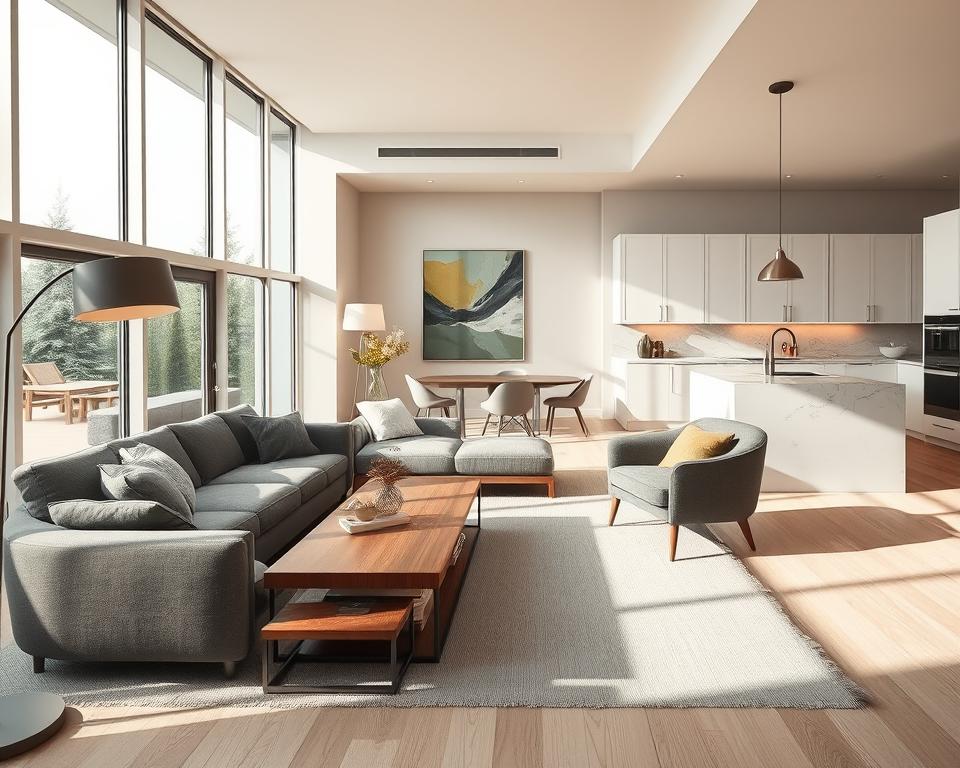
The choice between residential design and commercial design hinges on personal interests and career aspirations. Both interior design career paths present unique challenges and opportunities. It’s crucial to assess your skills, education, and experience before making a decision.
Specialized Career Paths in Interior Design
The interior design field is expanding, with specialized interior design career paths gaining traction. There’s a rising interest in sustainable design and healthcare design. These paths offer both creative satisfaction and the chance to positively influence the environment and human well-being.
The global Sustainability Consulting Market is projected to reach USD 14.1 billion by 2031. This growth is fueled by the escalating need for sustainable design across various sectors.
Beyond sustainable design and healthcare design, other specialized interior design career paths include hospitality design and corporate space planning. These roles demand a profound understanding of the industry and the skill to craft spaces that are both practical and visually appealing.
Building Your Professional Portfolio
A well-curated interior design portfolio is crucial for securing a role in commercial interior design. It’s vital for those fresh out of school or moving from residential to commercial design. The portfolio should be easy to navigate, with no slow load times. This is key to keeping employers interested.
Showing sketches and preliminary work alongside final designs can make your professional portfolio stronger. It highlights the design journey. A focused portfolio, concentrating on a specific area, prevents overwhelming potential employers. Key points for a robust portfolio include:
- Quality over quantity: showcase only projects you’d like to repeat and specialize in
- Incorporate narrative elements, like client stories and project outcomes, to engage
- Utilize portfolio-building software and platforms for a professional online presence
Employers understand that new graduates might lack extensive experience. This allows for including school projects or personal work in interior design portfolios. By customizing your portfolio to specific design niches and using high-quality images, you boost your appeal. This can lead to better career opportunities and advancement in career development.
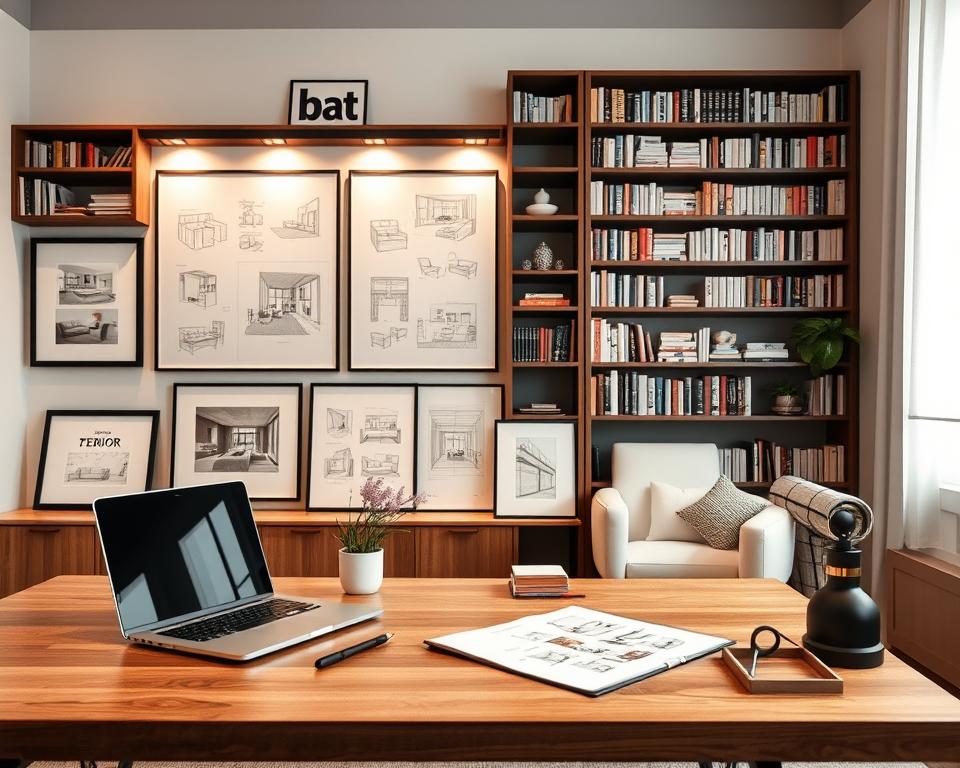
Using storytelling in project descriptions can make your portfolio compelling. By following these guidelines and creating a solid professional portfolio, interior designers can pave the way for success. This will help them reach their career development aspirations.
Salary Expectations and Growth Potential
Interior design salaries are influenced by several factors. The Bureau of Labor Statistics reports an average salary of $60,340. Experience, education, certification, and location all affect individual earnings.
Understanding interior design salaries requires considering various factors. Interior design jobs vary in pay, with some roles offering higher salaries. Experience significantly impacts earnings, with senior designers earning more than newcomers.
Here are some key statistics to consider:
- Interior designers typically earn a median annual salary of approximately $56,000, with the top 10% earning over $96,000.
- The employment of interior designers is projected to grow by 5% from 2022 to 2032, which is about as fast as the average for all occupations.
- 35% of interior designers are self-employed, indicating a significant portion of the workforce operates independently.
Interior designers have opportunities in residential, commercial, and healthcare sectors. Demand for sustainable design is increasing, leading to higher salaries for specialists. Grasping salary expectations and career growth potential aids in making informed career choices.
Technology and Tools in Modern Interior Design
Interior design technology has transformed the field, opening up new avenues for creativity and efficiency. Designers now use software and digital tools to craft detailed designs and presentations. This includes 3D modeling software like SketchUp, which enhances the accuracy of project visuals.
Proficiency in software like AutoCAD, SketchUp, and Revit is crucial for interior designers. These tools simplify the design process, making it easier to collaborate with clients and colleagues. Project management software, such as Trello and Asana, also plays a key role. It helps in organizing tasks and tracking deadlines, boosting team efficiency and productivity.
- Enhanced accuracy and precision in design representations
- Improved collaboration and communication with clients and colleagues
- Increased efficiency and productivity in the design process
- Expanded creative possibilities and operational efficiency
The interior design industry is constantly evolving. To stay competitive, designers must keep up with the latest technology, software, and tools. This ensures they deliver designs that meet client expectations and stay ahead in the field.
Networking and Professional Development
Interior design networking is vital for professional growth, affecting client acquisition and business expansion. Early-career designers often attend many events without seeing familiar faces, highlighting a need for better networking. A robust professional network can make a designer the go-to choice for property developers, opening up more client opportunities.
Industry-specific conferences, trade shows, and seminars offer targeted networking chances. They connect designers with suppliers, partners, and clients who match their work. Online platforms like LinkedIn, Houzz, and Instagram are crucial for marketing, showcasing portfolios, and reaching global potential clients. Hosting local events or webinars can establish designers as industry leaders and broaden their networks.
Some key benefits of interior design networking include:
- Discovering hidden job or internship opportunities not advertised publicly
- Connecting with professionals from fields like construction, engineering, real estate, and project management
- Referrals and recommendations from colleagues can lead to new projects and clients
- Attending industry events, conferences, and trade shows offers insights into new materials, design trends, and sustainable practices
By focusing on interior design networking and professional development, designers can increase their credibility and trustworthiness. Word-of-mouth recommendations can significantly impact career advancement, including job placements and promotions.
Effective networking strategies, like setting realistic goals, engaging in active listening, and following up, can enhance confidence and relationship-building. Professional development workshops on communication and networking can also improve networking skills. By investing time and effort into building a strong professional network, interior designers can unlock new opportunities and advance their careers in the competitive industry.
Conclusion: Launching Your Interior Design Career Journey
Starting your interior design career opens up a world of possibilities. With the right education and certifications, you can thrive in this dynamic field. Commitment to ongoing professional development is key to a fulfilling career.
The interior design world offers a variety of paths, from residential to commercial and specialized areas. Keep up with trends, enhance your technical skills, and build a strong network. Digital platforms and evolving tools can help showcase your talent and connect you with clients or employers.
The journey in interior design is a continuous learning and growth process. Be open to challenges, seek mentorship, and refine your career strategy. With dedication and a love for design, you’ll build a successful career in this inspiring field.
FAQ
What are the different career options available in the interior design industry?
What is the current state of the interior design industry?
What are the educational requirements and certifications needed to become an interior designer?
What are the differences between residential and commercial interior design?
What are some specialized career paths in interior design?
How important is building a professional portfolio in the interior design industry?
What are the typical salary expectations and growth potential in the interior design industry?
What technology and tools are used in modern interior design?
How important is networking and professional development in the interior design industry?

Rachel Branson is the creator of The Ponds Farmhouse, a blog dedicated to farmhouse décor and DIY projects. With a passion for helping readers create beautiful and unique homes that reflect their personal style, Rachel offers a variety of content, including simple and budget-friendly decorating ideas, DIY and craft projects, thrifting and vintage finds, and entertaining tips.
Throughout her life, Rachel has been an avid DIYer, always seeking budget-friendly ways to achieve high-end, boutique looks. She is fortunate to have the support of her husband, Brad, who assists with the heavy lifting and provides a voice of reason when new ideas arise. Their projects and decorating ideas have been featured in publications such as Farmhouse Style Magazine, American Farmhouse Magazine, and Real Simple.
Through The Ponds Farmhouse, Rachel shares her expertise and passion for farmhouse décor, inspiring readers to create homes they truly love.

